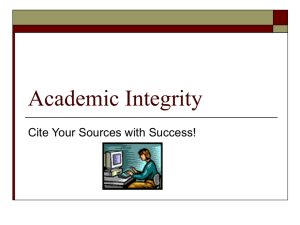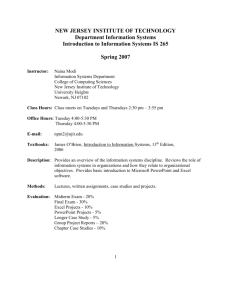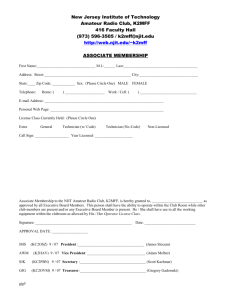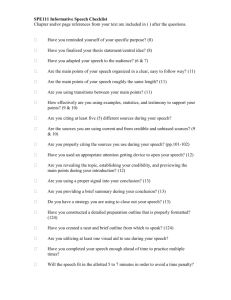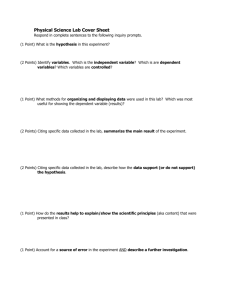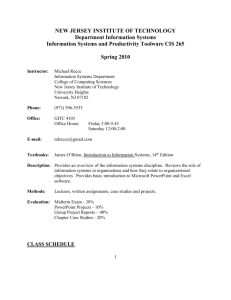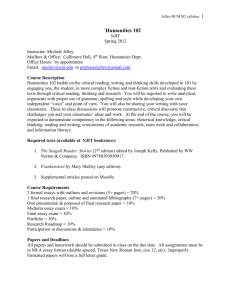Intellectual Property in the Digital Age
advertisement
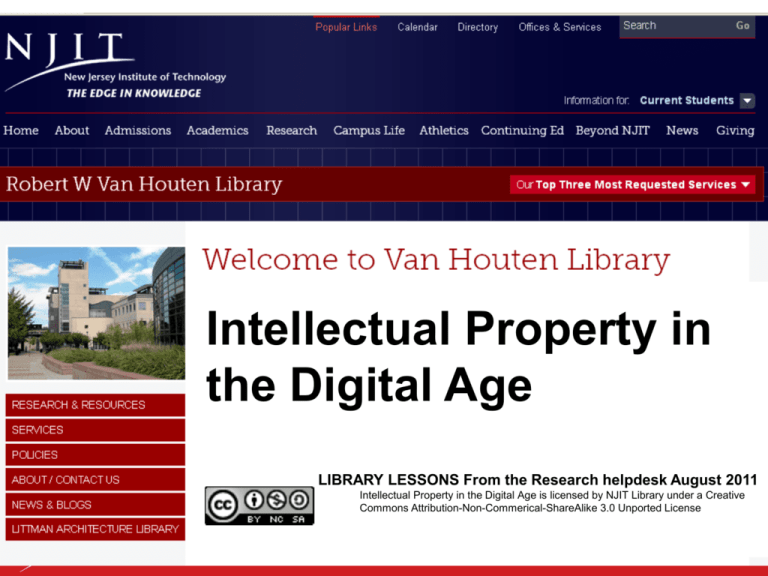
Intellectual Property in the Digital Age LIBRARY LESSONS From the Research helpdesk August 2011 Intellectual Property in the Digital Age is licensed by NJIT Library under a Creative Commons Attribution-Non-Commerical-ShareAlike 3.0 Unported License What is Intellectual Property? (2009). World Intellectual Property Organization 24 August 2009. http://www.wipo.int/about-ip/en/ Transmitting Ideas • • • • Use information to support your ideas. Credit the original authors by citing. Cite so the information can be found again. Build upon the ideas and knowledge of other people. Images: ©Vithalbhai Jhaveri/GandhiServe, Courtesy of The Thoreau Society, Lincoln, MA, MLK courtesy WMU Archives & Regional History. Who is an author? Who is a creator? • Anyone can be an author on the internet. • Give credit even when the author does not state they have © copyright or have a publisher (such as a book/journal/magazine). • Creators have rights. • Image from Free Microsoft Clip Art Understand your rights and those of others! Pay attention to Privacy Settings. Thomas, Owen. (12 Nov 2007). "Your Privacy is an Illusion. Bank Intern Busted by Facebook." Gawker (21 July 2009) http://gawker.com/tech/your-privacy-is-an-illusion/bank-intern-busted-by-facebook-321802.php What Is Copyright? “Copyright is a legal device that provides the creator of a work of art or literature, or a work that conveys information or ideas, the right to control how the work is used." Stephen Fishman, Esq. The Copyright Handbook, 1996. And Then There’s Copyright. (2009). NJIT Library Searchpath Tutorial 24 August 2009. http://library.njit.edu/researchhelpdesk/howto/searchpath/mod6/07-copyright.htm Public Domain The only thing you don’t have to cite is common knowledge. Something that everyone knows like who the president is. And Then There’s Copyright. (2009). NJIT Library Searchpath Tutorial 24 August 2009. http://library.njit.edu/researchhelpdesk/howto/searchpath/mod6/07-copyright.htm Fair Use the ability to use sources without seeking permission from the copyright holder Fair Use Poster 2001. American Library Association. 24 August 2009 http://www.ala.org/ala/aboutala/offices/wo/woissues/copyrightb/FairUsePoster.jpg Fair Use Allows you to • Quote passages from a book or a journal article as long as it is credited/cited • Reproduce short segments of songs and movies as long as it is cited/credited to the author. • use an entire work depending on the circumstances. Examples • Professor giving you a copy of an article • Photocopying selections of materials for your own use • Library Electronic Reserves Digital Literacy (2009) Cornell University 27 July 2009. http://digitalliteracy.cornell.edu/tutorial/dpl3330.html Citing Sources as Social Practice Citing is common & expected in scholarly work It’s the same thing we do on facebook or in IM’s with sending links but in professional and academic work, we call it citing. Image from Microsoft Clip ART Intext Citations and Works Cited Page • If you are citing information in your paper that means you include an in-text citation and the full citation at the end of the paper. Do not list citations in your work cited if you did not cite them in your paper • Get Ready for University. Intext Citation Example. (20090 Edinburgh Napier University. 21 July 2009 http://www2.napier.ac.uk/g etready/figures/citations_re ferences.gif Misuse of Sources Unintentional plagiarism •Wrongly paraphrasing •Paraphrasing without citing •Copying & Pasting When in doubt, just ask a librarian, professor, writing tutor. Make sure you credit ideas of authors, quote properly & paraphrase. Bruin Success. (n.d.) “Oops I plagiarized!” UCLA Library 21 August 2009. http://unitproj.library.ucla.edu/col/bruinsu ccess/03/01.cfm Mr. Biden insisted, however, that he had done nothing “malevolent,'' that he had simply misunderstood the need to cite sources carefully. Mr. Biden drew large chunks of heavy legal prose directly from (one article), including such sentences as: ''The trend of judicial opinion in various jurisdictions has been that the breach of an implied warranty of fitness is actionable without privity, because it is a tortious wrong upon which suit may be brought by a non-contracting party.'' Just One Footnote Dionne, E.J. Jr. “Biden Admits Plagiarism in School but Says It was not ‘Malevolent’” New York Times 18 September 1987. http://www.nytimes.com/1987/09/18/us/biden-admits-plagiarism-in-school-but-says-it-was-not-malevolent.html. 25 August 2009. This example comes from SearchPath: http://library.njit.edu/researchhelpdesk/howto/searchpath/mod6/05-paraphrasing.htm This is plagiarism in its worst form. • Abbie does not indicate that the words and ideas belong to Boorstin, leaving her readers to believe the words are hers. • She has stolen the words and ideas and attempted to cover the theft by changing or omitting an occasional word. Even though Brian acknowledges his source, this is plagiarism. • He has copied the original almost word for word, • He has not supplied quotation marks to indicate the extent of his borrowing. Chad has done a good job. • He identified his source at the beginning of the paragraph, letting readers know who is being quoted • He provided a footnote directing them to the exact source of the statement. • He paraphrased some of Boorstin's words and quoted others, but makes it clear to the reader which words are his and which belong to Boorstin. http://www.njit.edu/academics/integrity.php
